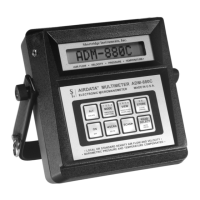ADM-880C 07/20/0956
14.5 DUCT TRAVERSE COMPARISON, INCLINED MANOMETER OR MICROMANOMETER
An inclined manometer or standard micromanometer does not correct for density effects due to barometric pressure or
temperature.
The density correction necessary for duct traverse readings which are to be compared with FlowHood readings taken with
the TemProbe in place is as follows:
Where: P
b
= local barometric pressure (in Hg)
/F = temperature of measured air stream
If the TemProbe is not attached during the flow measurement, the FlowHood meter will assume standard 70
/ F conditions
(as do the inclined manometer and the standard micromanometer). In this case, it is not necessary to correct the duct
traverse velocity for the density effect due to temperature. However, since the FlowHood does automatically correct for the
density effect of barometric pressure, the duct traverse readings must be corrected as follows:
Where: P
b
= local barometric pressure (in Hg)
14.6 DUCT TRAVERSE USING THE AIRDATA MULTIMETER
No corrections for density are necessary when the AirData Multimeter is used for the comparison pitot tube traverse if use
of the TemProbe is consistent during both the air flow measurement using the FlowHood and the velocity measurement using
the AirData Multimeter and pitot tube. This means that, if the TemProbe is used, it must be used for both
types of
measurements.
If the TemProbe is not used for either flow or velocity, it must not be used for the other type of measurement. In this case,
both sets of measurements will be calculated using standard 70
/ F conditions.
14.7 BACKPRESSURE COMPENSATED COMPARISON READING
Perform a multipoint pitot tube traverse of a supply duct which serves a single supply diffuser. Calculate the air flow with
careful attention to all of the factors discussed in this section. A backpressure compensated reading on this same diffuser
should be within ± 5% of the air flow calculated from this traverse.
14.8 NONBACKPRESSURE COMPENSATED READING
After determining the air delivery by duct traverse, measure and record the duct centerline velocity, both with and without the
FlowHood (flaps open) in place. (A reduction in the duct centerline velocity when the FlowHood is placed over the diffuser,
is caused by the flow resistance (backpressure) of the FlowHood).
A flaps open, nonbackpressure compensated FlowHood reading on this same diffuser should be within ± 3% of FLOW
2
(calculated from the ratio of the two centerline readings).
FLOW
2
is obtained from the following calculation:
Where: Flow
1
= flow calculated from duct traverse
Flow
2
= flow in duct with FlowHood in place (flaps open)

